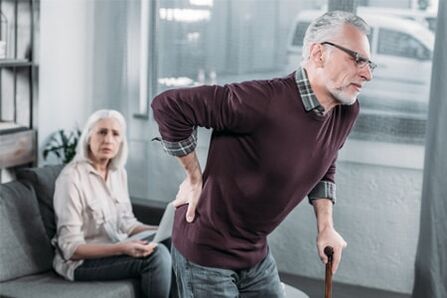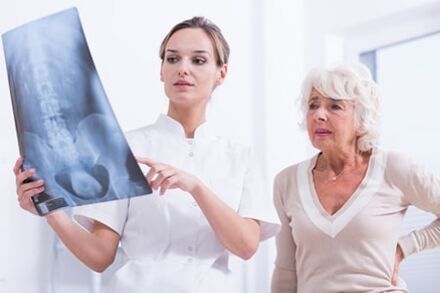
Degenerative-destructive lesion of the spine, otherwise:osteochondrosis- a disease that involves damage to a person's ligament and joint equipment, intervertebral discs and vertebral bodies.
Osteochondrosis disease primarily affects older people, regardless of gender, although it should be noted that there has been a recent trend to rejuvenate the disease. Such rejuvenation of osteochondrosis is directly related to the poor physical development of children and the predominance of many adolescents. In addition, modern young people prefer to spend time sitting near a TV or computer, avoiding sports. The combination of these factors leads to weakening of the back muscles, postural disorders and other negative consequences for the spine.
Osteochondrosis and its causes

At the heart of osteochondrosis disease is a disorder of the trophism of the vertebrae and intervertebral discs that alters the normal structure of tissues. As a result, the disc loses its normal flexibility and shape, reducing the width of the gap between the vertebrae. Violation of the intervertebral ratio leads to compression of the nerve endings in the spinal cord as well as significant overexertion of the spinal muscles, which explains the manifestation of pain in osteochondrosis. In addition, severe complications often occur in osteochondrosis, such as bulging of a portion of the intervertebral disc and damage to the vertebrae.
In the future, degenerative-destructive changes in osteochondrosis will lead to the development of bone outgrowths in the vertebrae, extending to the intervertebral ligaments and small joints of the spine. People with osteochondrosis have difficulty bending-extensor movements and may develop pathologies over time - scoliosis or kyphosis.
All of these degenerative-destructive lesions of the spine are usually the result of the inevitable physiological aging of the human body, but the process of osteochondrosis can be significantly accelerated for a number of reasons discussed later in this publication.
It should be noted at once that there is no single cause of osteochondrosis, but there are a number of predisposing factors, the main ones being:
- bruises, fractures, dislocations and other damage to the spine;
- hereditary predisposition;
- prolonged wear of various diseases of the foot causing overload of the vertebrae, such as goosebumps, flat feet and others, as well as uncomfortable and tight shoes;
- obesity or overweight;
- age-related natural changes in the body;
- violation of metabolic processes in the body;
- maintaining a sedentary lifestyle;
- abrupt cessation of professional sports;
- characteristics of professional activity, such as frequent twitches and turns of the body, weight lifting, uncomfortable posture at work;
- prolonged and frequent hypothermia exacerbated by high humidity;
- the presence of frequent and prolonged stressful conditions.
Several or even one of the above factors can lead to osteochondrosis, which is traditionally divided into four stages:
- First phase- a decrease in the amount of moisture in the intervertebral disc with a decrease in the distance between the vertebrae. In this case, smaller cracks appear in the cartilage.
- Second phase- due to the reduction of the gaps between the vertebrae, the sagging of the ligament and muscle system occurs, which entails the unnatural mobility, displacement and slippage of the vertebral bodies.
- Third stage- due to progressive degenerative-destructive changes of the spine, intervertebral disc prolapse and vertebral subluxations occur.
- Fourth section- bone osteophytes grow between the vertebrae to prevent subuxions and unnatural movement of the vertebrae, in folk medicine these are called "salt deposits" which increase over time so that the vertebrae lose their motility. .
It should be noted that in the first and fourth stages of osteoarthritis, patients do not experience pain.
Osteochondrosis and its classification
Although osteochondrosis has many classifications, the most common is the classification of osteochondrosis, which takes into account the localization of spinal lesions:
- osteochondrosis of the cervical spine;
- osteochondrosis of the thoracic spine;
- osteochondrosis of the lumbar spine;
- osteochondrosis of the sacral spine;
- common osteochondrosis, which involves disease of two or more vertebrae.
Osteochondrosis and its symptoms
Osteochondrosis, as a disease, is chronic in nature and is characterized by an alternation of the remission phase and the exacerbation phase, in which the symptoms of osteochondrosis are particularly characteristic, depending on the location and presence of the spinal cord disorder. about possible complications.
Thus, osteochondrosis of the cervical region is characterized by pain directly in the neck, hands, some stiffness of movement, headache, and numbness of the fingers. Well, in the case of compression of the vertebral artery, the patient has a pulsating headache, a decrease in the functions of the hearing aid, dizziness and fainting are also possible.
The symptoms of osteochondrosis of the thoracic region are slightly different. The patient is concerned about aching back pain, which can be acute in nature, difficulty breathing, pain in the heart, and the so-called "cola in the chest" in folk treatment.
Symptoms of osteochondrosis include pain in the lower back, legs, and sacrum in the lumbar spine, and get worse during movement. In addition, numbness of the legs occurs and various disorders of the urinary tract may develop.
During the remission phase, the sick person may also experience pain that is not pronounced and only occurs in the presence of provocative factors such as an uncomfortable position in the patient's body.
Osteochondrosis and its diagnosis

Above all, patients should consider that a neuropathologist is involved in the treatment of osteochondrosis. The diagnosis of osteochondrosis usually involves the following steps:
- questioning the patient;
- external examination and palpation of the patient's spine in different positions of the body and the creation of a possible range of motion;
- special studies to diagnose osteochondrosis through nuclear magnetic resonance imaging, computed tomography, and X-ray examination of the patient;
- special examinations of peripheral nerves and blood vessels, but only in cases necessary for the correct diagnosis of osteochondrosis.
If you do not deal with osteochondrosis in a timely and correct manner, preferably without the use of folk remedies, there is a risk of developing various complications in the form of diseases such as sciatica, disc herniation, migraine, vegetovascular dystonia. , and lumbar osteochondrosis - also spinal cord. Therefore, due attention should be paid to the diagnosis and treatment of osteochondrosis, avoiding independent alternative therapies to prevent the onset of the disease.
Conservative treatment of osteochondrosis
In the treatment of osteochondrosis in medical institutions, in contrast to traditional medicine, classical methods of treatment are used. However, the attending physician takes a strictly individual approach to the patient. The treatment of osteochondrosis is performed in a complex way to achieve efficacy. Conservative methods of treating osteochondrosis can be divided into the following groups:
- Treatment of osteochondrosis with medication.
- Physiotherapeutic treatment of osteochondrosis, especially magnetotherapy using special medical devices.
- Sanatorium treatment of osteochondrosis.
- Organizing proper nutrition with the help of a special diet.
Surgery in the treatment of osteochondrosis
Surgical treatment of osteochondrosis is performed only when the above conservative methods do not provide the desired effect. The most common is removal of the intervertebral hernia, where the surgical incision does not exceed one centimeter, and the patient can recover the day after such surgery. Well, complete rehabilitation of the patient will be completed within six months after surgery.
There is also a method of treating osteochondrosis by surgery, in which the affected intervertebral disc is removed and replaced with a silicone implant or prosthesis, leading to and as a result of restoring the required distance between the vertebrae. , elimination of symptoms of osteochondrosis.
Prevention of osteochondrosis
First, to prevent osteochondrosis:
- avoid increased stress on the spine by wearing comfortable shoes;
- try not to stay in an awkward position for a long time;
- regularly control your weight, avoiding the yoke of being overweight;
- always follow the correct posture;
- use both hands evenly when lifting weights;
- perform general strengthening exercises daily and pay attention to regular yoga classes or in the pool;
- follow your diet with foods such as fish, leafy vegetables and greens, dairy products, jelly and jelly, broth, eggs, butter and olive oil;
- avoid alcohol, carbonated drinks, too strong coffee, salty foods and fatty meats.






















